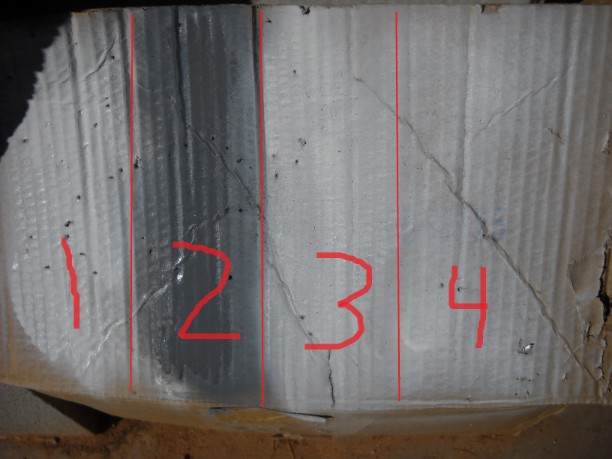 | The Primer is pictured to the left. I purchased two cans of the stuff from an ebay vendor for less than normal retail. Average Price per can is between $11.00 to $12.00. I paid just over $8.00 plus shipping per can. The claim to this primer is that it is made for small, highly detailed figures for war gaming. Dungeons and Dragons, World of Warcraft, Military Figurines and the like. Below is Test Subject #1. My "Fire" Medallion, sculpted by Rebecca Turner. He's a good test because a) he's flat, b) he's got hundreds of pin holes and imperfections, and c) he's easy to strip if I need to. |

The picture above is the cardboard spray test. The sprays are as follows:
1- Krylon Indoor/Outdoor White Primer
2- Rustoleum Painters Touch Grey Primer
3- Krylon Flat White Paint
4- The Army Painter White Matte Colour Primer
Note that I sprayed each can for 10 seconds, spraying up and down the cardboard. The picture was taken while the paint was still wet, to show that even though they were all sprayed for the same length of time, the Painters Touch was the only paint that pooled.
The Army Painter didn't cover the black lettering all the way either, which could be good or bad. Good that it doesn't lay down thick like the Painter's Touch, but it will take more layers to get full coverage.
Test Two
I had lying around the bottom part of a ISH tail. It was guinnea pig number two.
I purposely sprayed the tail heavy to see how much it would take to obliterate detail, and to see how much it would take to 'screw' up a piece. It wasn't hard to do with this primer. When sprayed directly and without much movement, the paint fills in detail quite nicely.
Test Three
Next I wanted to see how light the primer could be sprayed. I followed the directions on the can and sprayed an old rubber horse that I am not sure is a Schlech or not, but it worked for the purpose. This guy has hair detail and a gross thick seam running down his barrel.
I really liked the way it covered yet didn't obliterate all the detail in the hair texture. My normal method of spraying horses is to cover my left hand with a towel designated to the job while holding the horse in that hand, and spraying with my right. I spray from a distance of about 14-16 inches away from the horse. Any further back from that distance, and I loose too much spray into the air.
This way I can not only keep the horse moving but the can as well. Spraying into a box never worked for me as I had issues getting under the belly, under the tail, and other tight places like that. The method I use works to get into those tiny tight spaces, and If I need to move the can closer or farther away it is easy to do so.
I liked the way the primer covered the horse. It didn't feel like it took that much paint to cover all the details yet kept them from being obliterated.
Test Four
Now it was time for the medallion. The two pictures below were taken literally 3 seconds apart. The left one was in full direct sunlight, and the right one was in full shade. (The difference between one step on and off my patio.) You can see how shiny the paint is while still wet.
The medallion was sprayed maybe 10 times in various directions, shaking the can in-between passes. I didn't get full coverage on the medallion though, there were spots in the mane and background that didn't get covered fully.
The medallion was allowed to dry for the second coat. It didn't say on the can how long it would take to dry, so I left it on my porch for a good hour before coming back for the second pass. I'd say though that by the time between spraying, and when I was done taking pictures it was dry to the touch. It had a smooth somewhat chalky feel to it.
Pictures below are of the second pass.
Final Thoughts
The one problem I ran into was the can decided to quit spraying halfway through the second pass of the medallion. I don't know if I didn't shake the can properly enough or if I ran out of paint? It felt like it still had paint in it, but I wasn't completely sure. The makers claim you can spray an 'entire miniature army with just one can' but I don't know how many individual peices that works out to.
I bought two cans, and my next test will be on a traditional horse. I have several here that are next in line to be sprayed. If the second can screws up like the first one did, I'm going back to the company and asking for a refund. With a price tag of over $10.00 a can, that is simply unacceptable.
I also have not yet sprayed any of these tests with Dull Cote, or any sealer yet, so nothing on how they react together yet. I will play with the rubber horse and some earth pigment powders with the Dull Cote to see how it all plays together.
Over all I liked the primer. I liked how it covered, I liked that it didn't wipe out the detail at all. You can't beat the price for a primer that won't ruin half of your CM detail. However, the can messing up and refusing to spray the paint really is a downer.
It dried very fast, and I like that as well. No fingerprints!
I also am going to attempt stripping the tail part to see how easy it is to remove also, so all of that will be in part two.